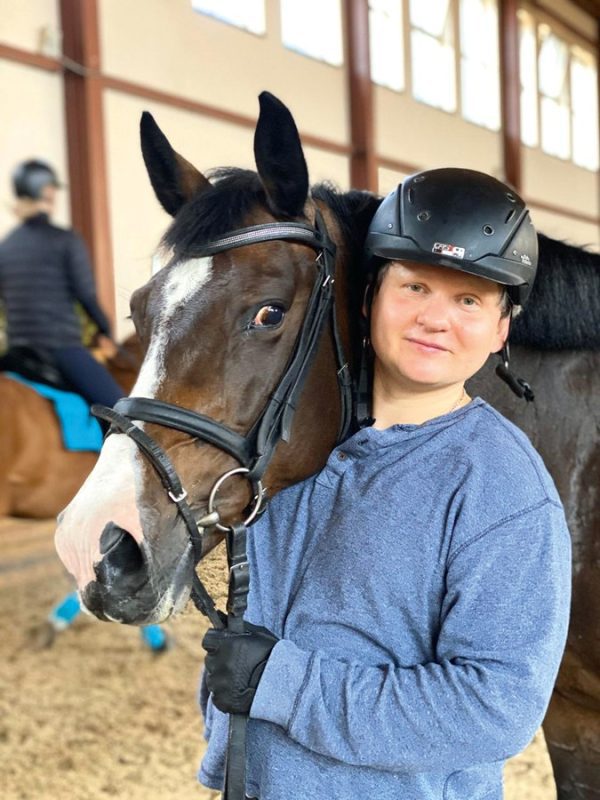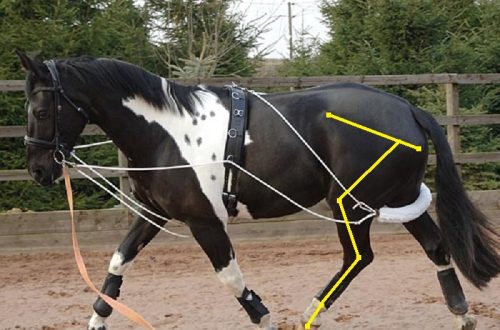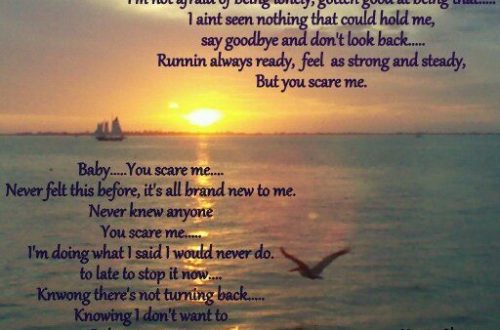
Sports horse breeding in Russia. Sergei Nabatnikov: my journey 2016–2020
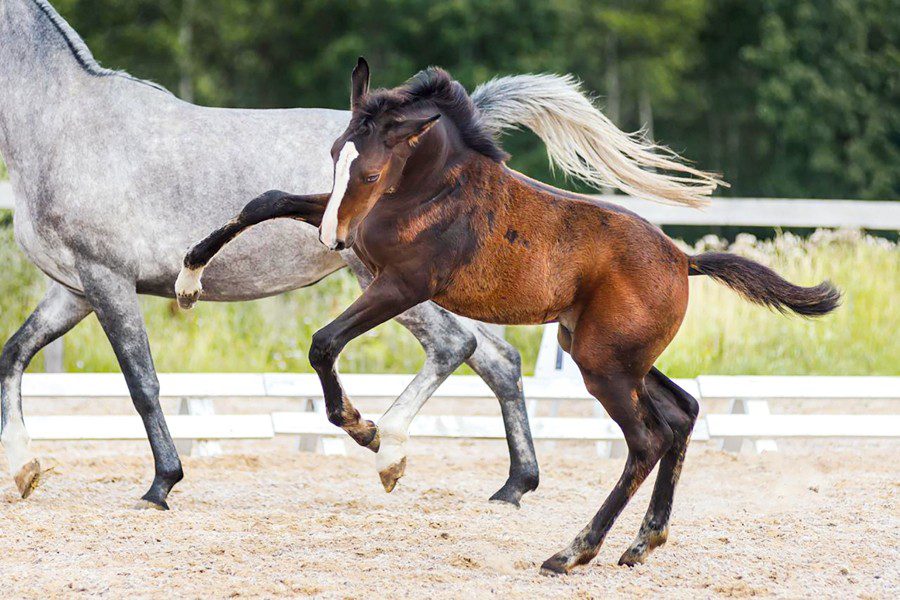
Filly born in 2020 by VIGO D’ARSOUILLES and Coretta Fila (Ramiro mare stamm 776)/ FThis is provided by Sergey Nabatnikov.
Do you dream of living in contact with beauty? I hope this article helps you choose the right path.
Remarkable methods for the development of horse breeding and horse dressage are reflected in the scientific and educational works of the early and mid-twentieth century. Among many of them, I will highlight the following: Prince S. D. Urusov “The Book of the Horse”, V. G. Obolensky “The Fundamentals of Horse Breeding and the Horse Medical Book”, Marshal S. M. Budyonny “The Book of the Horse”, and, of course, the unsurpassed James Phyllis Basics of dressage and riding. It is difficult to imagine, for example, a backward gallop on three legs. How did the Phyllis do this? Who is able to approach him in the understanding of the horse after 100 years? “I use the whip only when working on the spot,” the master wrote in his book, “and then while I teach the horse to lean forward and yield to the spur. Once I’m in the saddle – whip off. A real rider needs a leg and a rein. Bad – whip.
These authors, of course, influenced the point of view presented here, and their works will find proper use in our stable “Equestrian Club Russian World”, located in the suburbs, 15 km from Sheremetyevo Airport, created specifically for breeding work and training young horses in show jumping .
There is a generally accepted formula for success in show jumping: 60% horse genetics, 40% rider work. This, of course, is a very rough division: an infinite number of subtleties in breeding, keeping, feeding, preparing a horse from birth to the moment of the race, training and tournament schedule, the work of a groom and even a horse transport driver – all this affects the athletic performance of a horse. Mistakes in each of these aspects add up exponentially, reduce the chances of having a foal (the main hope of every breeder and horse owner) to a high sporting performance, and can lead to the complete loss of a horse for sport use at any stage.
Back to the past
The last highest achievement of domestic athletes and horses in show jumping was team gold at the Summer Olympic Games in Moscow in 1980. After that, neither Soviet nor Russian show jumpers won prizes at the Olympic Games, World Cup finals, European championships. I am not an expert to assess the professionalism of our athletes. Let me speak exclusively about horses.
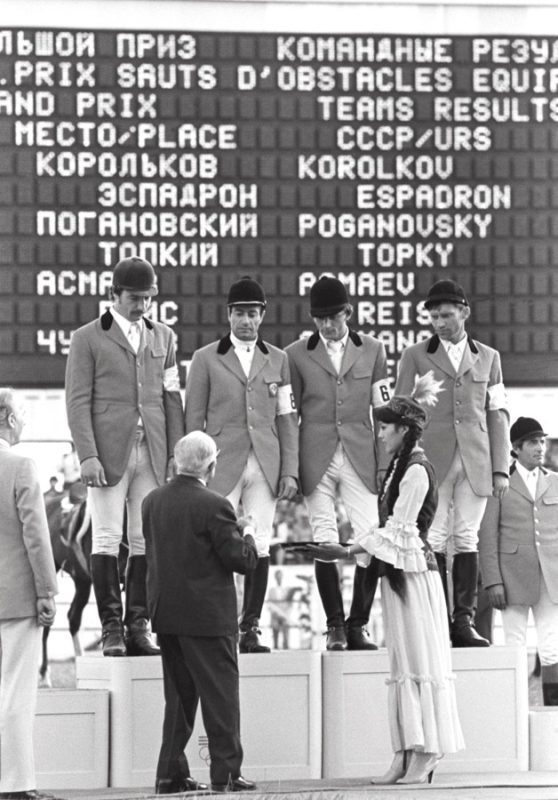
Awarding of the USSR national show jumping team – winners of the 1980 Olympics in Moscow (photo: Valery Zufarov / TASS photo chronicle).
So, in our “golden” Olympic team in show jumping, stallions performed: Hepatitis, born in 1972. under the saddle of Vyacheslav Chukanov, Topkiy born in 1972 under Viktor Poganovsky, Flight born in 1967 paired with Viktor Asmaev and Espadron, born in 1971 under the saddle of Nikolai Korolkov. Thus, the last winning horse in show jumping was born in the USSR (Russia) 48 years ago!
In conversations with many titled athletes of the older generation, I found out that in the USSR and Russia at the end of the last century, horses were not bred to compete in Olympic sports. All horses had to be tested at the hippodromes, and those who did not show the proper result on the track got into equestrian sport. Today, in the XNUMXst century, it is unfortunate to state the fact of investing huge public funds in the development of hippodromes, and leaving behind an industry that employs an order of magnitude more people (groomsmen, groomers, coaches, athletes). The youth sports industry is one of the main elements in the system of youth education.
At the same time, in Europe, in particular in Germany, after the Second World War, they realized that the military use of the horse, as well as agricultural use, had ceased to be relevant, so state stables and private breeders 70 years ago began to rebuild the breeding policy to satisfy quickly growing demand in the equestrian industry. The heads of stud farms in our Fatherland many years ago did not realize the changes in the world of horse breeding, and time was irretrievably lost.
To the leaders. Two unused chances
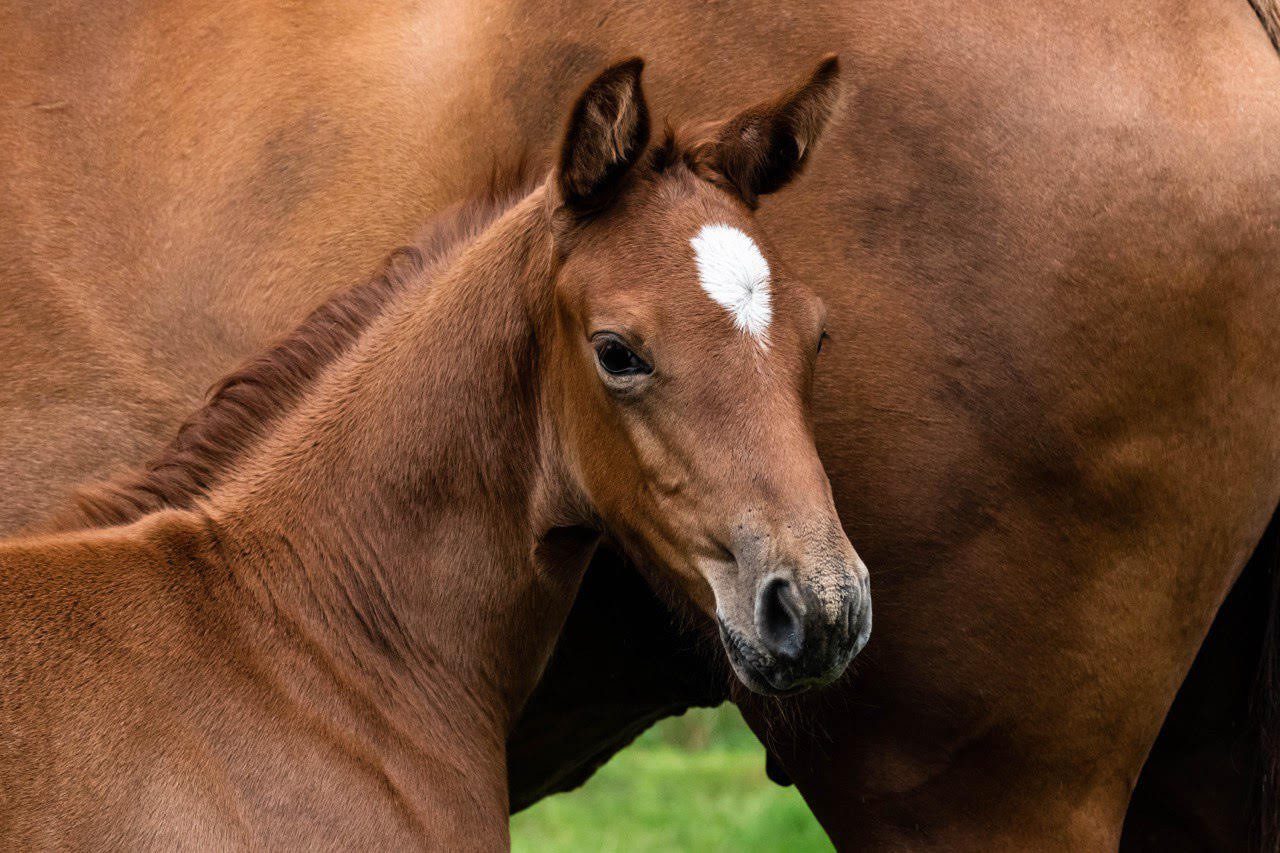
PRETTY BUTTERFLY RUSSE Z. Filly born in 2020 (H&M BUTTERFLY FLIP mother family)/ ФThis is provided by Sergey Nabatnikov.
However, we still had a chance to overtake the West in sports horse breeding – unique biotechnologies in the USSR overtook the whole world! In 1930, Professor Ilya Ivanovich Ivanov for the first time successfully applied the technology of artificial insemination with semen dilution and storage outside the body. Also, technologies were developed for freezing the sperm of valuable stallions, and the survival of the embryo under storage conditions at ultra-low temperatures was proved. European breeders’ associations began to build a network of reproduction centers using frozen semen only in the early 1960s. And today, more than 50% of the top-class foals in the world are born using technology that was once developed in our country.
The second chance for a technological breakthrough was the technology of embryo transplantation developed at the All-Russian Research Institute of Horse Breeding. In 1976, S. G. Lebedev created a laboratory at the All-Russian Research Institute of Horse Breeding and, for the first time in Europe, washed an embryo (fertilized egg) without surgical intervention and transplanted into a surrogate mare. The principles of embryo transfer developed by Lebedev have not changed much in 45 years. The main advantage of using embryo transplantation is, of course, the possibility of obtaining up to five offspring per year from elite mares without withdrawal from the sports schedule or from mature mares who are no longer able to bear a foal on their own. Oh, if in the late 1970s there were people in the management of the industry who appreciated the development of Lebedev! We had top-class mares in those years! In Western Europe, embryo transfer began to be widely used only 15 years later – in the second half of the 1990s. A great chance to become an industry leader was once again missed…
In the 2002st century, IT technologies make it possible to study arrays of statistical data on the results of horses in sports and their pedigrees. The most valuable resources are the horse breeding databases Horsetelex and Hippomundo, which help to conduct breeding work. The reasons for conducting my breeding work in show jumping, for today exclusively in the direction of the European half-breed pedigree group of horses, were mentioned above. For your convenience, the names of the horses are in English. I don’t have complete statistics on the number of great horses that have been produced from embryo transfers from world class elite mares. Here are the nicknames of some of them: London Olympics silver medalist GLOCK’S LONDON (CAREMBAR DE MUZE) born in 1999, CORNET OBOLENSKY (WINDOWS VAN HET COSTERSVELD) born in XNUMX, VAGABOND DE LA POMME (2005), CROWN Z (2000), KAFKA VAN DE HEFFINCK (2010) DIAMANTHINA VAN T RUYTERSHOF (2003). The cost of each of the presented horses is several million euros. The breeding results using the above technologies are, of course, brilliant. It is sad that today in Russia we have what we have.
Basis selections.
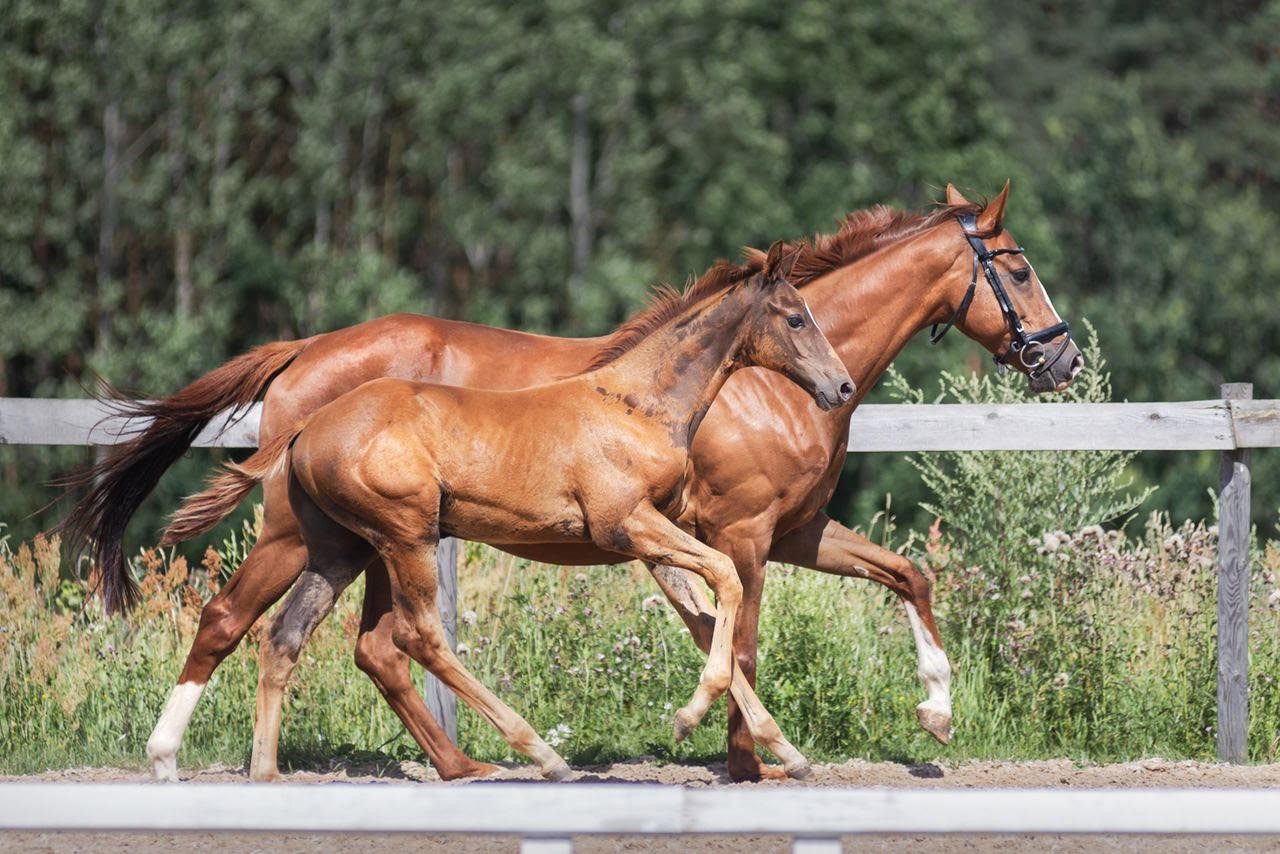
Voce Russe Z, stallion born in 2020 (Vigo D’ARSOUILLES x Fidelia (Ramiro mare stamm 776)/ photo courtesy of Sergey Nabatnikov.
Who is more important in selection? Stallion or mare? Despite a well-known tendency to take the opposite view, I discovered in 2016 that breeding is not always a gamble. A good mare, in combination with good stallions, increases the chances of a successful product in horse breeding, and this is exactly what is needed. Who is more important? Here is the theorem: over the years, many of the top horses are born from the best proven broodlines or sport mares, tested in the sport at a level of at least 140 cm, I will try to assure you of this with the example of my own horses.
Let’s look at the world auctions of embryos and foals. It turns out that the prices for embryos from the same stallion vary significantly. At the Flanders Foal Auction in Sharjah (UAE) on January 31, 2018, the price of an embryo from a stallion CASALL ASK, who has earned more than 2 million euros in his career, is the third stallion in the WBFSH SIRE RANKING 2019 – JUMPING after CHACCO BLUE and DIAMANT DE SEMILLY in , in combination with the S-class mare VALENTINA VAN’T HEIKE (under the saddle of the Belgian Jos Lansink, she won a number of victories in the Grand Prix of 5 * tournaments, started at the 2012 Olympics in London and helped to take the 3rd team place for the Belgian team at the VKI 2010 year in Kentucky) amounted to 60 thousand euros, including the auction fee, taxes and insurance. On August 3, 2019, the foal CAÏRO VAN’T GOEDLEVEN (CASALL ASK), born to the mare CARICE KEY SR Z, was sold with auction fees and taxes to the Flanders Foal Auction in Beervelde (Belgium) for 15 euros. The stallion CASALLATO PVDB (CASALL ASK), born to the mare TAMINA, descended in turn from the mare GOLDKUESTE I, who is also the mother of CORINESSA H, riding under the saddle of Ibragim Yuldashev (Uzbekistan), on May 5, 2018 was sold for 17 thousand euros on Opglabbeek Flanders Foal Auction (Belgium).
The price at the Hannover online auction in 2020 for CASALL ASK children under the age of up to weaning did not rise above 20 thousand euros.
I will present the mares, the value of which for the world jumping, as well as financial, is difficult to overestimate. 1. NARCOTIQUE DE MUZE II (DARCO-QERLY CHIN), born in 1997 using embryo transfer technology. 2. CARTHINA Z born in 2000 3. RABANNA VAN COSTERSVELD, born in 1994, mother of stallion CORNET OBOLENSKY. Any of the presented mares has given sports horse breeding more than all the mares taken together in our USSR, and then in Russia for 48 years! Examples of great horses born from sport mares: CHACCO-BLUE (CONTARA – 150 cm), EMERALD (CARTHINA Z – 145 cm), QUIDAM DE REVEL (DIRKA – 160 cm), CORNET OBOLENSKY (RABANNA VAN COSTERSVELD – 145 cm), RAMIRO Z (VALINE – 150 cm), COMME IL FAUT (RATINA Z – 160 cm). So, “look for a woman”! Mare – 70% of success in horse breeding. The theorem is proven – the value of the stallion is secondary!
Fathers and Sons. About the role of stallions
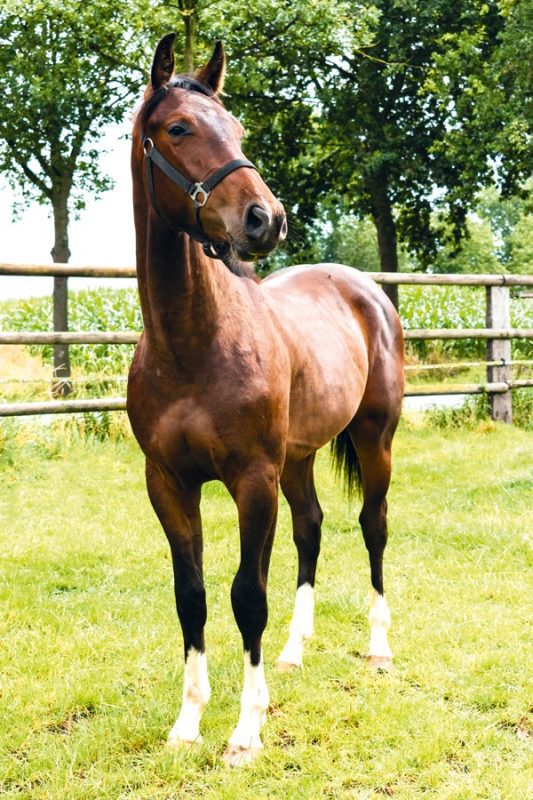
Chacco Star Russe Z. Stallion born in 2019 / photo courtesy of Sergey Nabatnikov.
A mare cannot improve itself! In 2019, at the RGAU-MSHA them. K. A. Timiryazev gave a lecture by one of the leading experts in Germany, Axel Brockmann (there is a video of her on the Web, if you are interested in our article from a practical point of view, please take a look). For me, the presented material has become a good and very capacious guide for the final understanding of how stallion selection works in Europe.
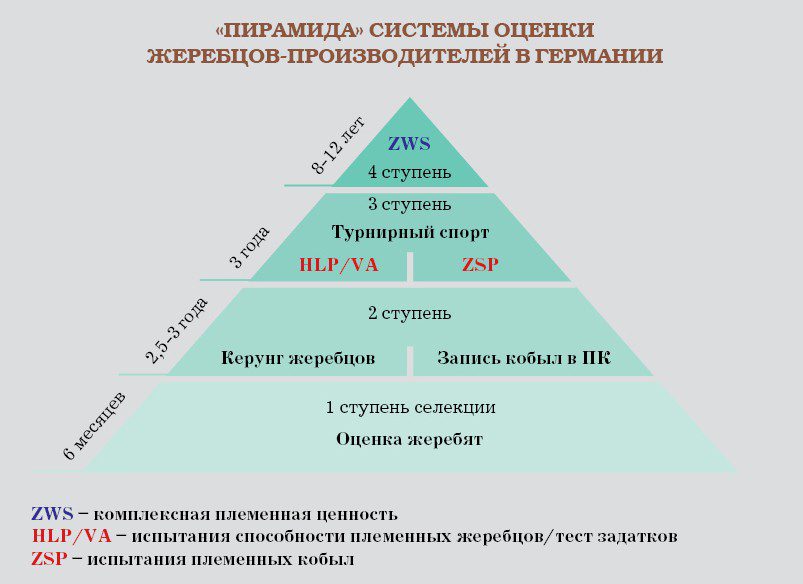
The minimum stallion rating level is kerung. CORNET OBOLENSKY (WINDOWS VAN HET COSTERSVELD) was born in 1999 in Belgium. Flexible, flexible, allure, with excellent jumping technique, he amazed everyone present at the kerung in 2001 in Münster so much that he was recognized as the second winner of the kerung with a total score of 8,33 points, and for the free jump the stallion received the highest score of 10 points. In big sports, CORNET performed at the S-class level under the saddle of Marco Kutscher (Germany) and became the winner of dozens of 5* level Grand Prix, including routes of the European Championship, World Cup and Nations Cup stages, Samsung Super League final in Barcelona in 2007 and 2008 years. At a relatively young age – 13 years old – Cornet ended his sports career. The amount of the prize stallion, however, was not as large as that of many of his sports counterparts. However, the stallion (or rather, its owners) achieved much greater financial success as a producer.
It is important to note that I did not hear anything in Axel’s lecture about the fact that young kerung stallions, not tested in sports, whose children have not yet been born, are always a risk. Risk is the destiny of professionals, today I do not consider myself a professional breeder, therefore I improve my mares with stallions from the list of the top ten top 100 best stallions in the world. The stock of our horses today is born from CHACCO-BLUE, DIAMANT DE SEMILLY, CASALL ASK, VIGO D’ARSOUILLES.
Second step. More important in the assessment are the results of the stallion in sports.
An example of a CASALL ASK with its outstanding results in terms of prize money is shown above.
The third and most important step is the results of the stallion’s children in sports.
To date, the best sire in the world is CHACCO-BLUE. The cost of a straw of his seed is currently over 30 thousand euros, which is an absolute record for sports horse breeding. His kids win! Chacco himself has never won the Grand Prix of the CSIO5*, CSI5* levels. And, for example, LADYKILLER XX, COR DE LA BRYERE, CONTENDER – famous stallions that gave a whole galaxy of finalists and winners in major competitions (these stallions even have monuments), have never competed at all!
As I wrote above, there are no stallions in Russia whose children have achieved success at the level of 5* tournaments, therefore I think that in order to obtain ambitious results it is advisable to use the seed of outstanding stallions from the top 10 world rankings. The price of a seed ranges from 30 thousand euros for a straw of CHACCO BLUE to 600 euros for a straw of CORNET OBOLENSKY and 300 euros is the cost of a straw of the outstanding NABAB DE REVE, which has been in the leaders of the stallion rating for more than 10 years. I think Axel Brockmann presented the material correctly, but did not say the main thing – he did not reveal the open secret: “Look for a woman!”
Modern horse breeding. My path under the Russe brand
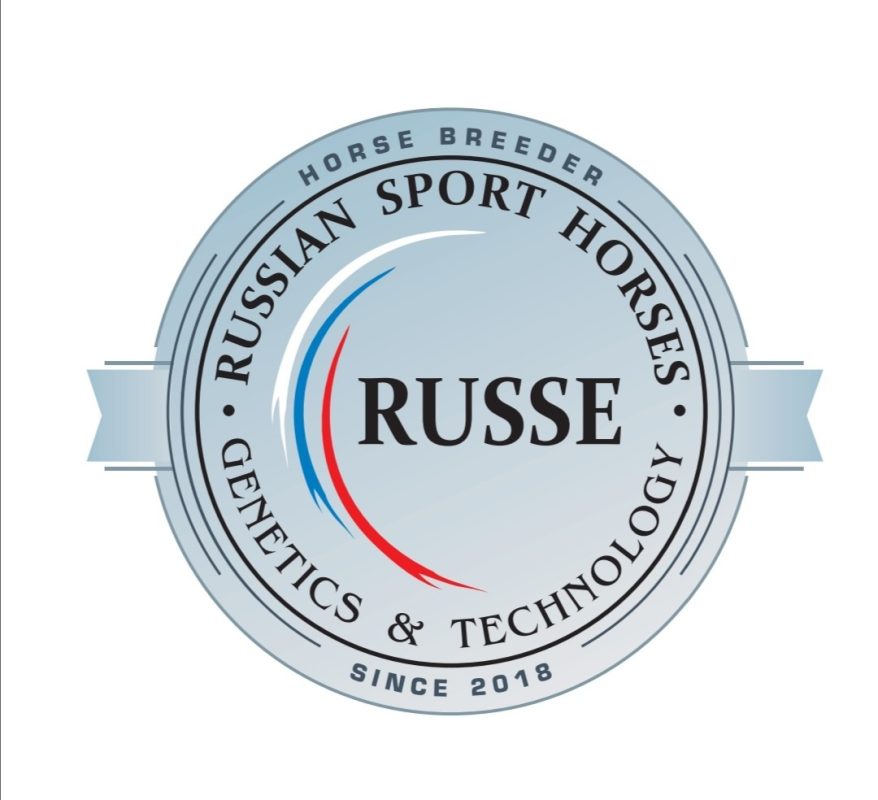
Today, the result of the selection of the plant TM “Russe” was the presence of foals from the best uterine lines in the world.
The excellent VALENTINA VAN’T HEIKE is already a mother of two 160cm 5* horses.
Our stallion CAVALIER RUSSE Z (CASALL ASK), born in 2018, is preparing for the kerung in Lanaken, which takes place in parallel with the World Junior Championships.
ODILE DE HAAR is the mother of KANNABIS VAN DE BUCXTALE, who three times became the champion of Belgium among young horses at six, seven and eight years old, vice-champion in CSI5*W 160 (La Coruna) vice-champion of CSI4* 160 in Chamorin. She was born a stallion CHACCO STAR RUSSE Z (CHACCO-BLUE) in 2019.
World class mare ARIELLE, who won the Grand Prix of the World Cup stage in 2007 (Mechelen) under the saddle of William Whitaker, is the mother of EMERALDA RUSSE Z born in 2019. (EMERALD), an excellent successor of a magnificent uterine line.
MOSCA RUSSE Z born in 2019 is the daughter of the mare CALL ME DE MUZE born in 2012, performing at the level of 140 cm, and the granddaughter of RATINA GAMMA Z, a clone of the great Ratina Z. By the way, GAMMA is the only RATINA clone whose children are currently successful in sports.
H&M BUTTERFLY FLIP, unforgettable World Cup champion in Geneva in 2003, two-time Olympic participant (team silver medalist in Sydney), became the grandmother of our filly PRETTY BUTTERFLY RUSSE Z in June 2020.
I reasonably expect that a world-class horse has already been born in our country, or will be born from the presented mares already in the third decade of the XNUMXst century.
The mares presented above are worthy of being mothers of several foals a year. The composition of mares from first-class families of the world level in show jumping allows us to hope to break away from other show jumping breeders for at least five years.
The presence of first-class own genetic material both on the paternal and maternal lines will allow us to receive embryos from our own mares that have reached the age of two already in 2021. Embryos will be transplanted into surrogate mares or frozen and delivered for transplantation in Russia. I hope that domestic veterinarians will participate (learn) in this process, because the world’s best laboratories for embryo transplantation and IVF of horses are ready to cooperate with us.
Unfortunately, all our attempts to create a public organization – the association of horse breeders “Russian Sport Horse” have not been successful to date, and because of this we are forced to register our horses in the international Belgian studbook Zangersheide. It’s a pity!
There is safety in numbers. Only forward!
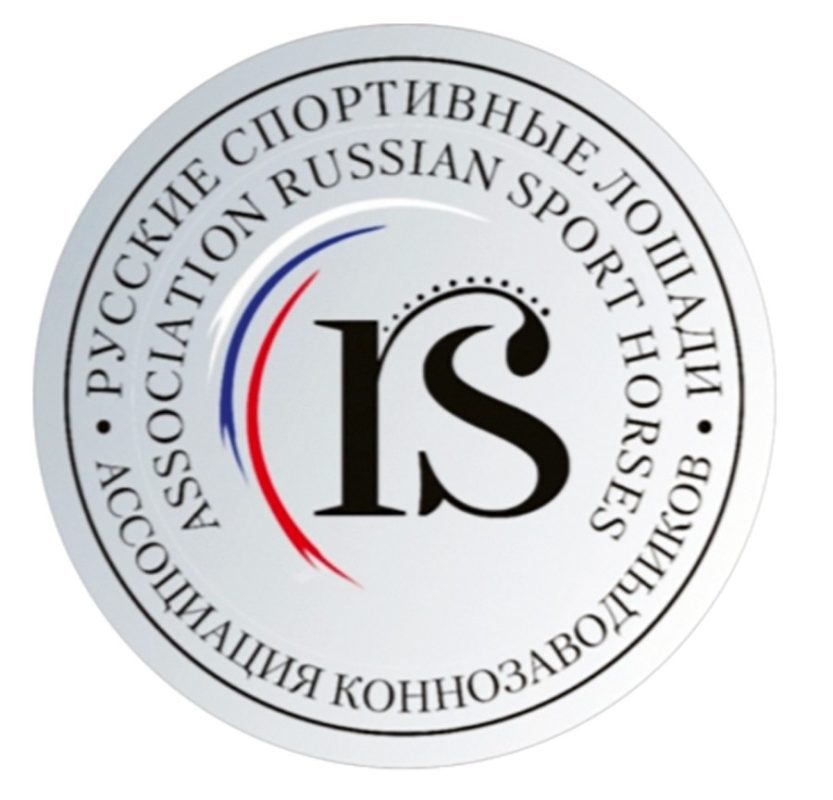
As mentioned above, the time for an unconditional victory in competition with the West has been lost. More than 10 years ago, Western science was able to clone super-elite horses – in our livestock there are descendants of RATINA Z clones (the MOSCA RUSSE Z mare from the RATINA GAMMA Z mare) and GEMINI CL XX of the GEM TWIST XX clone, which is the paternal grandfather of our PRETTY BUTTERFLY RUSSE Z
Without streamlining the vector of development of industry representatives in the genetic, veterinary, zootechnical, scientific, financial and sports areas, we will achieve our goals much more slowly than we could. Back in 2016, being a member of the Holstein Association, I took care of the translation of the association’s charter, from which I learned about the system of its work and the significance of stallion kerungs, the admission of stallions for breeding based on sports results and the assessment and admission of mares. The development of a system for evaluating foals and preparing them for sports, which, of course, should incorporate both the Soviet experience and the advanced world experience, is a matter of collective work, including show jumpers and breeders.
The idea of creating an association, including the development of national rules (recommendations) for the preparation of young animals, a system of competitions for young horses, the creation of a network of horse reproduction centers of the association, tools for selling foals of the association, a system for training groomers, preparing a memorandum on veterinary and legal aspects in the sale of horses, agreements support between breeders and athletes… Mikhail Safronov… Who else? Such a system is beneficial for horse breeders (all the leading associations of the world own several outstanding expensive stallions) – members of the association receive significant discounts on semen, often on terms of payment upon pregnancy or the birth of a foal, which reduces risks. Associations of breeders cooperate with top-level athletes, have rider training schools. Such cooperation, of course, is beneficial to domestic athletes.
Down with competition, long live cooperation! Breeders, owners of mares, unite! In continuation of communication – write, call. I hope I didn’t bore you. I will express my thoughts on breeding work in the direction of domestic breeds (Budennovskaya, Donskoy) in the next article.
Sincerely, Sergey Nabatnikov.
+ 7 (903) 792 92 26,
[email protected]
